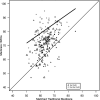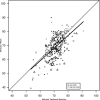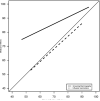Medicare beneficiaries more likely to receive appropriate ambulatory services in HMOs than in traditional medicare
- PMID: 23836738
- PMCID: PMC3925369
- DOI: 10.1377/hlthaff.2012.0773
Medicare beneficiaries more likely to receive appropriate ambulatory services in HMOs than in traditional medicare
Abstract
With quality-of-care bonus payments now available for Medicare Advantage health maintenance organizations (HMOs) and for accountable care organizations in traditional Medicare, the need to understand the relative quality of care delivered to Medicare enrollees has increased. We compared the quality of ambulatory care from 2003 through 2009 between beneficiaries enrolled in Medicare Advantage HMOs and those enrolled in traditional Medicare, and we assessed how the performance of various types of Medicare HMOs differed from that of traditional Medicare for these same measures. We found that beneficiaries in Medicare HMOs were consistently more likely than those in traditional Medicare to receive appropriate breast cancer screening, diabetes care, and cholesterol testing for cardiovascular disease. We also found that Medicare HMO physicians were rated less favorably by their patients than were physicians in traditional Medicare in 2003; however, by 2009 the opposite was true. Not-for-profit, larger, and older Medicare HMOs performed consistently more favorably on clinical measures and ratings of care than for-profit, smaller, and newer HMOs. Our results suggest that the positive effects of more-integrated delivery systems on the quality of ambulatory care in Medicare HMOs may outweigh the potential incentives to restrict care under capitated payments.
Keywords: Elderly; Managed Care—Medicare; Medicare; Quality Of Care.
Figures





References
-
- Gold M, Jacobson G, Damico A, Neuman T. Medicare Advantage 2012 Data Spotlight: Enrollment Market Update. Kaiser Family Foundation. 2012 Jun; [May 20, 2013]; Available from: http://www.kff.org/medicare/upload/8323.pdf.
-
- Brennan N, Shepard M. Comparing quality of care in the Medicare program. Am J Manag Care. 2010 Nov;16(11):841–8. - PubMed
-
- Landon BE, Zaslavsky AM, Bernard SL, Cioffi MJ, Cleary PD. Comparison of performance of traditional Medicare vs Medicare managed care. JAMA. 2004;291(14):1744–52. - PubMed
-
- Keenan PS, Elliott MN, Cleary PD, Zaslavsky AM, Landon BE. Quality assessments by sick and healthy beneficiaries in traditional Medicare and Medicare managed care. Med Care. 2009 Aug;47(8):882–8. - PubMed
Publication types
MeSH terms
Grants and funding
LinkOut - more resources
Full Text Sources
Other Literature Sources
Medical

